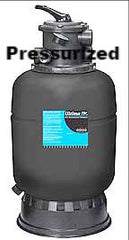
Non-pressurized:
Non-pressured filters have a non-airtight lid, allowing atmospheric pressure to enter the top area of the filter. The water exits these filters and returns to the pond by gravity flow. Some can be gravity fed, most are pump fed. A few are gravity fed, pump return. The plumbing must proceed away from the filter in a downflow configuration. As such this type of filter must be located in the landscape at a higher elevation than the point at which the returning water exits the final plumbing.
Upflow or Downflow:
Two types of non-pressurized, gravity return filters are currently used. One uses a simple plumbing exit port which is connected to the return pipe plumbing. The second has a waterfall weir (spillway return) plastic trough which spills water into a headwater area to a waterfall. Both of these non-pressurized style filters can be of an upflow or downflow configuration, depending on the position of a baffle inside the filter itself. The "upflow" or '"downflow" aspect refers to the direction of water flow through the filter. Based on our experience, we prefer the upflow type. Any time you cause the unfiltered water to flow against gravity you will always accomplish the dropping out of solid waste, thereby separating the waste from the water before it gets to the filter media.
Submersible:
Submersible filters are an in-pond non-pressurized type which are typically used on beginner ponds. They rest on the floor of the pond and have a submersible pump attached to them. The suction side of the pump is connected to the filter box which houses filter media. Unfiltered pond water is drawn through the media under the suction pressure of the pump. These filters are the highest maintenance type. They bog the pump over time since they work on the suction side of the pump. Since they are in the pond, they require physical removal to clean. Its best use is with very small, first time ponds or better yet, for short term holding tanks.
Advantages:
We prefer non-pressurized filters in general for the following reasons: 1) They typically require less pump horsepower to operate than pressurized filters because they are not required to force water through the filter. 2) You can easily see and therefore evaluate the condition of the media. 3) Power outages do not cause rapid depletion of dissolved oxygen in the filter because the media is exposed to the atmosphere. Non pressurized filters can take a little more time to set up than pressurized filters. They also have somewhat limited location possibilities in the landscape due to their gravity return nature.
Pressurized:
Pressurized filters are relatively simple to install. Most use plastic sphere or other similarly shaped plastic media which semi-floats in the upper portion of the canister during filtration. Pressurized filters must be connected to the discharge (output) side of a pump. Since water is forced through them, they require more horsepower to operate and often more power to backflush. Some require additional maintenance air blowers to assist in the backflush mode. All spend more of the pump's pressure to operate than non pressurized filters. All vastly benefit from the use of a prefilter. None allows for easy and complete viewing of the media without opening the filter, requiring some simple tools.
